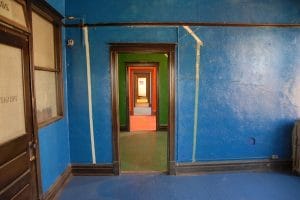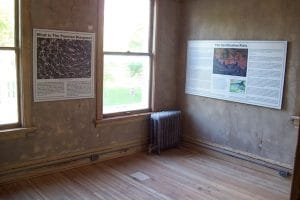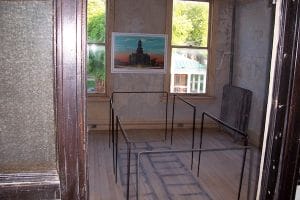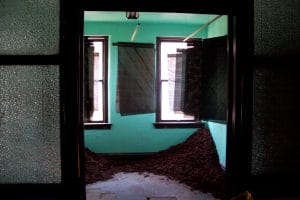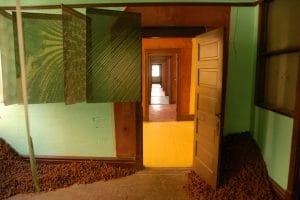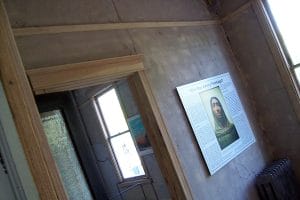Overview
This Kcymaerxthaere Historical Site offers a glimpse of the rich heritage of the Parisian Diaspora, the many towns and gwomes founded by Amory Frontage (pronounced fron-TAHJ) in his search for good fertile ground (known as “paris” in the cognate tongue).
Though he founded at least 30 towns and is credited with many other sites as well, the heart of the Parisian Diaspora were the 16 culturally Parisian gwomes that formed the FTLP (Fraternitee de Tout Les Paris). Aedguerre gwome (of which this Paris in iIllinois was the capital) was known as the Jewel and the Sword of the Parisian Diaspora, and tended to dominate the alliance. Each of the 16 gwomes had an embassy on this floor. It is important to note that Kymaerican embassies tended to be small because the generally small size of the gwomes in both land — or water —and population made it difficult for any gwomes to support more than a few permanent embassies at any one time. Many gwomes had no embassies at all.
Access
The location of Embassy Row is 116 N. Main Street.
Access to this place can be obtained by going to Dalbey Designs during their business hours.
Dalbey Designs is at 112 N. Main St Paris, Illinois. Please be respectful of their time–if things are busy, it may be a minute or two before people can find the key.
Public Dedication
This Kymaerican Historical Site was dedicated April 22, 2006. Followed closely by the dedication of the Faerie Traces Marker.
This was Kcymaerxthaere installation #019. It was the second Kcymaerxthaere Historical Site and the 18th installation in what we call the United States.
Text of the Site
The part of the story installed here:
Embassy Row: Heart of the Parisian Diaspora
WHO WAS AMORY FRONTAGE?
Amory Frontage (pronounced fron-TAHJ) is the individual most responsible for the remarkable number of Parises that are scattered across our continent. In his time, he was a legend for his ability to roam the landscape in search of productive lands. He never considered himself an adventurer, but rather a man who planted seeds that others tended. Today, if he is known at all, it is, of course, as the forebear (either father or grandfather) of Earl Frontage, the most important early explorer of Kymaerica. But is doubtful that Earl Frontage’s achievements would have been possible without the wisdom of the Time Guides that his father passed on to him.
Early Days
Little is known of Amory’s early days. He is believed to have been born on a small farmstead on the Pleins of Abraham, near what we would call linear Montreal. There were 11 brothers, of which he was the sixth. Being near the great seaway of the Saint Lawrence river, he and his family met many people from divers gwomes and young Amory became a master of languages as well.
He became enamored of the dialect that today we call Parisian because, although it was spoken by only a small group of people, that group included the great astronomer Charles Messier, who happened to be a neighbor. One cold clear winter night, Messier showed him the beautiful constellation familiar to us as the Pleiades. Messier called it Emmeu Quatrixieme Cinq—in the Cognate that means roughly “M45” and in the False Cognate it means “the growing family.” Though that constellation would figure prominently in Amory’s life and the lives of those he lead, it was not until he came here to the Paris of Aedguerre (iIllinois) that he found the connection.
The Diaspora Begins
As a young man, Amory Frontage showed an almost uncanny understanding of soil. In fact, the word Paris in the cognate tongue can mean both “good ground” and those who search for it. When a drought struck many gwomes along the St Lawrence seaway, he gathered a group of young families and farmers around him and promised to find them all somewhere better to till the earth. The group is known to have stopped in the Land of the Warres (near linear Lake Erie) in their travels, before any foundings, but otherwise the record of the first journey is sparese (a Cognate term mean spare or sparse).
Many strongholds of the Diaspora claim to be the first Paris founded on this journey, but no one can be certain (most historians have narrowed it down to the gwomes of Terredumerre, Toiseaux, Millieu, Aquilon or Pleiade). But whichever one it was, the soil was indeed uncommonly fertile and productive. But, as would happen ultimately with all the Parises, after a few years, Amory himself was invariably itching to move on. When the moment came, he would call a town meeting and usually by the end of it took about half the citizens on to the next adventure. Bear in mind, of course, by the time he left a Paris, each population was much bigger and able to survive a split. There were always people (whether the Malheurs, the Dunnes, the Ving-Senks, to name a few) wanting to take a chance on finding something even better.
What is the Parisian Diaspora?
Strictly speaking, the Parisian Diaspora is made up of all of the descendants of all the people who traveled with Amory Frontage. in his quest for “good ground” across Kymaerica. In the main, that tends to mean all residents of the communities actually founded by Amory Frontage in his search. Furthermore, in common parlance, it has come to mean anywhere the Parisian dialect survives with some vigor, so that includes a few offshoots of the original settlements—such as Pearce or Perry (pronounced pare-EE).
However, at the time that this structure was in use, the Diaspora referred to a group of gwomes (the Cognate term that means “Footprint of the Nation”). Most scholars say there were 16 gwomes with a Paris as the capital (this group is known as the FTLP). All of those gwomes were represented in the original Embassy Row. In addition, there are known to be 33 Parises which Amory Frontage founded on his original journey. You can see their maps around the corridor later in your visit. There were many other places which he visited, saw or named or that his people named in honor of the adventure. The exhibit in room 210 – the original home of the Embassy of Millieu — gives some sense of their status in today’s linear world.
The Certification Riots
When Amory Frontage founded several Parises in the district of E’re Iowa and laid out their fertile cornrows, he could not have known he was also planting the seeds of the destruction of the Diaspora as any kind of meaningful political entity.
The canard is often repeated that the Parises that were in the district of eIowa (the “e” stands for “e’er” and is silent) fought over the right to represent the district in councils like this. This, of course, is impossible, because a district (like iIllinois or pCalifornia [the “p” is silent]) had no political status in Kymaerican times. In fact, even as a geographic entity, these district names probably meant something much different to people of that era than they do in ours.
What is true, is that all the Parises of E’re Iowa were also under the dominion of the Grid. The Grid was a culture (not exactly a religion per se, but certainly a belief system) centered in Exira (a town which is now in linear Iowa). It was literally the center of that world. The Grid was determined by a careful demarcation of an imagined grid (to call it imaginary could have gotten one executed at certain times) centered at a spot just outside the Our Lady of the Grid Church. Many of the rigid township systems and squarish county lines in that part of the continent are an artifact of this time.
Five Parises In The GRID
Over a period of time that encompassed two complete life cycles of the local brood of cicadas, Amory Frontage founded 5 different Parises in the lands ruled by the Grid. He is known to have traveled outside the area at least once during that time, so they were not all founded consecutively. At first, there was not too much of a problem, though proximity did bring its cousin: rivalry. But the nature of The Grid culture was something that ebbed and flowed according to the beliefs of the high priestess of the Our Lady of the Grid church. Sometimes the associations were loose and all the member gwomes were essentially independent, other times they had to follow strict rulings. Interestingly, even formerly independent gwomes would instantly kowtow. This philosophy was known as “freedom on a chain,” and it was a cornerstone of Grid belief.
The gwomes of the five Parises were: The True Grid Home of Paris (TGHP); Vray Maysonne (called Vray); The Grid Paris (TGP); Paresse; and Pas Du Paresse. However, the last one was only one town and the whole gwome was not culturally Parisian (thus the name), and it was not a factor in the riots. The four other Paris were relatively small in population (though they were not the smallest Parisian gwome) and so had agreed to a rotation of membership in the Fraternitee and thus the use of the embassy. Furthermore, their soil was identical and therefore, in the spirit of Amory’s vision, it seemed appropriate to consider them one.
But, as the chain was pulled tighter, the economic benefits of being the rotating member grew greater (exports and imports through Parisian Charter, etc) and when the TGHP received membership, in the normal course of time they determined not to relinquish it. When the delegation from TGP arrived to replace them, the TGHP refused to yield. A stalemate ensued. The TGP took the high ground and the delegation sat outside the door of the TGHP office. The Fraternitee was appalled, but unable to agree on the proper course because it was essentially an internal matter.
A Hearing In Paris
Finally, the Fraternitee agreed that the situation was untenable (who would be the proper military partner, for example, be?) and decided to hold a Certification Hearing where all 4 Parises from the realm of The Grid could present their views. If three out of four favored a certain approach, the Fraternitee would honor that.
This was bad news for the TGHP and they knew it. They recruited a mob from West Terre Haute and reinforcement from back in the homeland to intimidate the hearing. Getting wind of this, citizens from TGP, Paresse and Vray also mobilized and, by forced march (and, some said, Time Guides), by the time of the hearing thousands of bitter, uninformed people surged through the streets of this Paris.
The hearing began at dawn following the first full moon after the Pleiades left the sky (probably March). The capital building (now used as the courthouse) was packed and the crowd filled the square. The hearing lasted all day and things were going against the TGHP. The 15 ambassadors retired to consider their verdict. The crowd was anxious. Even supporters of the TGHP didn’t see how they could prevail, now that the mob opposed to them, if anything, outnumbered them.
After a short time, the representatives of the 4 Grid Parises were summoned to hear a unanimous verdict. Everyone knew what that meant. But Javertal, the leader of the TGHP, was nowhere to be found. Suddenly, there was screaming. The mob surged towards this building and bedlam broke out. Javertal had climbed the wall of the monastery next door and entered this building from the 4th floor. Sneaking down, he had begun trashing room 205. He figured if the TGHP would have been banned for a long time, and if they could not have it, no one could.
Rumors spread and soon there was wide spread fighting, looting and vandalism around the town square. Fires started and, after an orgiastic 5 days of destruction and 56 deaths, half the buildings were destroyed or damaged beyond repair. Even the glorious capital was a smoldering ruin. Ironically, the second floor of this building was the only part of the Fraternitee to survive. Javertal himself, appalled at what he started, fended off the flames for all 5 days, before disappearing onto the roadways of Kymaerica.
The present day courthouse was built according to the specifications of the old and gradually the town grew back, but the Fraternitee was never the same, though the flag that hangs here today belongs to the TGP, the real irony is that the unanimous verdict that was reached would have required the other three grid Parises to allow the TGHP back into the rotation.
Room 210
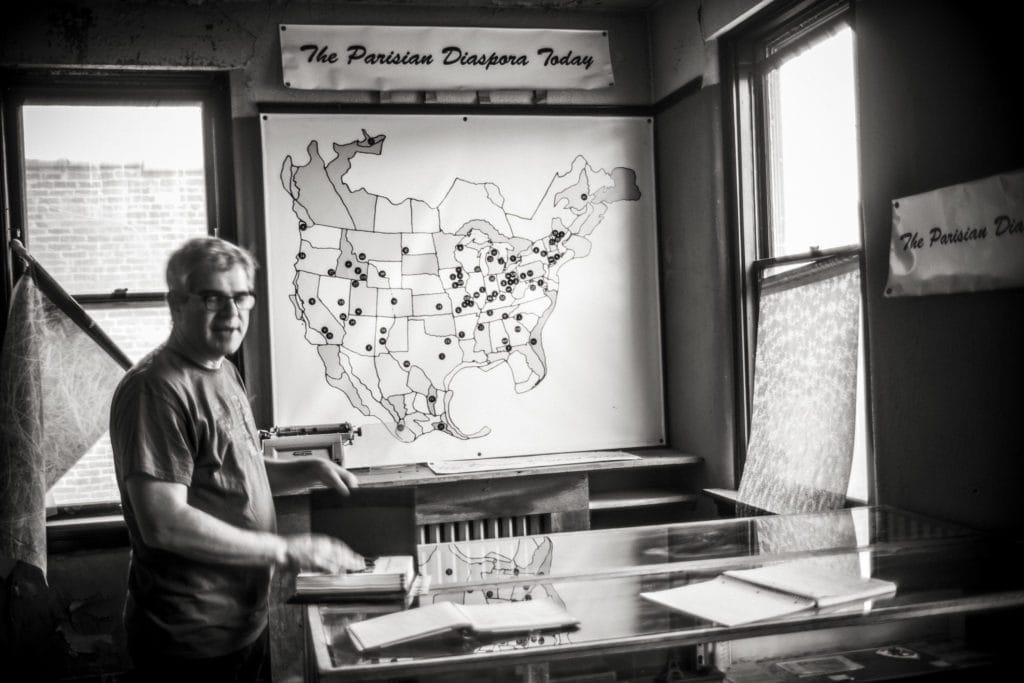
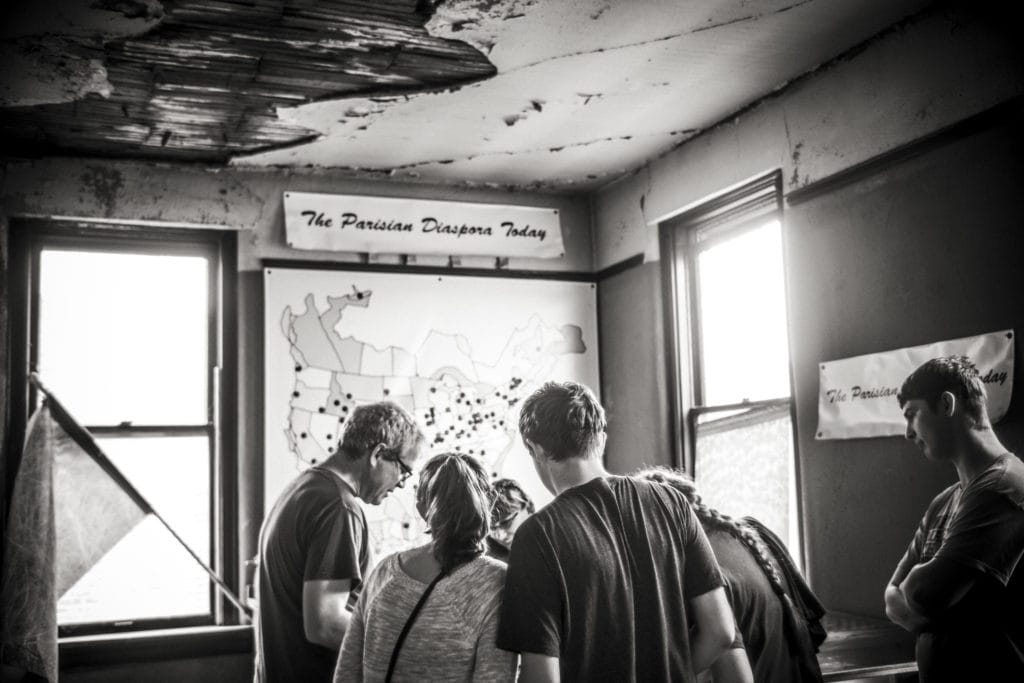
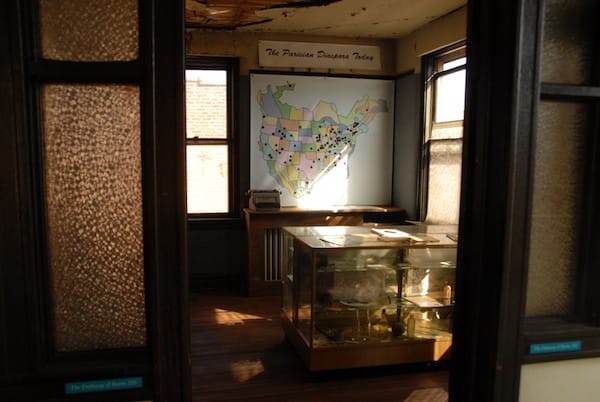

Room 210—formerly the site of the embassy of Millieu—is today the Center for the Exhibit of the Parisian Diaspora Today. The map on display shows clearly the wide influence of Paris across Kymaerica, specifically areas that settled directly by Frontage or his descendants.
The 16 Gwomes of the FTLP
This is the flag room of the Embassy Row historical site. Here one can see the Texture Flags of all 16 culturally Parisian gwomes that had their embassies along Embassy Row. They are listed here:
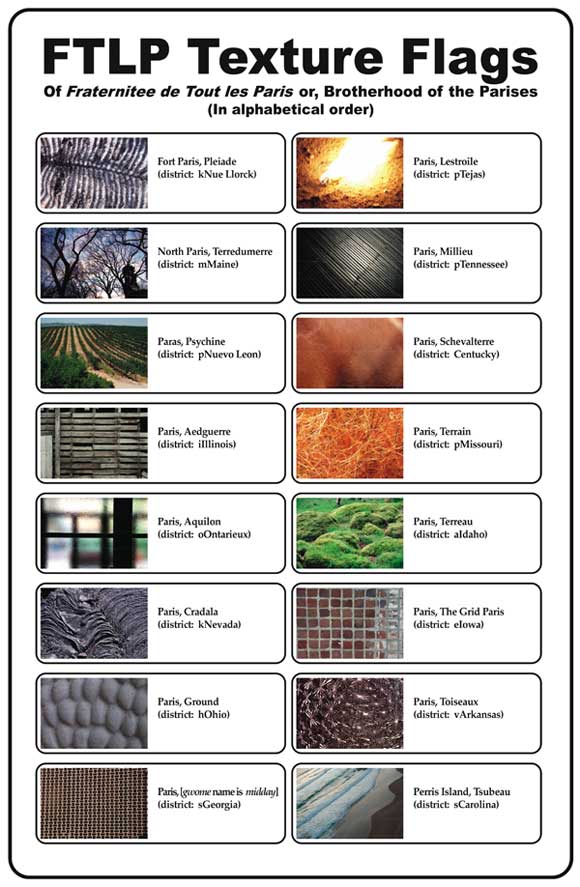
The Texture Flags of the 16 gwomes of the FTLP.
About Amory Frontage
Amory Frontage (pronounced fron-TAHJ) is the individual most responsible for the remarkable number of Parises that are scattered across our continent. In his time, he was a legend for his ability to roam the landscape in search of productive lands. He never considered himself an adventurer, but rather a man who planted seeds that others tended Today, if he is known at all, it is, of course, as the forebear (either father or grandfather) of Earl Frontage, the most important explorer of Kymaerica. But is doubtful that Earl Frontage’s achievements would have been possible without the wisdom of the Time Guides that he learned from his father.
Early Days
Little is known of Amory’s early days. He is believed to have been born on a small farmstead on the Pleins of Abraham, near what we would call linear Montreal. There were 11 brothers, of which he was the sixth. Being near the great seaway of the Saint Lawrence river, he and his family met many people from divers gwomes and young Amory became a master of languages as well.
He became enamored of the dialect that today we call Parisian because, although it was spoken by only a small group of people, that group included the great astronomer Charles Messier, who happened to be a neighbor One cold clear winter night, Messier showed him the beautiful constellation familiar to us as the Pleiades. Messier called it Emmeu Quatrixieme Cinq—in the Cognate that means roughly “M45” and in the False Cognate it means “the growing family.” Though that constellation would figure prominently in Amory’s life and the lives of those he lead, it was not until he came here to the Paris, of Aedguerre (iIllinois) that he found the connection.
The Diaspora Begins
As a young man, Amory Frontage showed an almost uncanny understanding of soil. In fact, the word Paris in the cognate tongue can mean both “good ground” and those who search for it. When a drought struck many gwomes along the St Lawrence seaway, he gathered a group of young families and farmers around him and promised to find them all somewhere better to till the earth. The group is known to have stopped in the Land of the Warres (near linear Lake Erie) in their travels, before any foundings, but otherwise the record of the first journey is sparese (a cognate term mean spare or sparse).
Many strongholds of the Diaspora claim to be the first Paris founded on this journey, but no one can be certain (most historians have narrowed it down to the gwomes of Terredumerre, Toiseaux, Milieu, Aquilon or Pleiade). But whichever one it was, the soil was indeed uncommonly fertile and productive. But, after a few years, Amory himself was inevitably itching to move on. As the Parises grew, he always took about half the citizens and moved on. There were always people (whether the Malheurs, the Dunnes, the Ving-Senks, to name a few) wanting to take a chance on finding something even better. And, of course, by the time he left a Paris, each population was correspondingly greater.

Another view of one of the Embassies.
Texture Flags of the FTLP
Every gwome in Kcymaerxthaere had a unique texture flag, capable of fluttering in many dimensions at once.
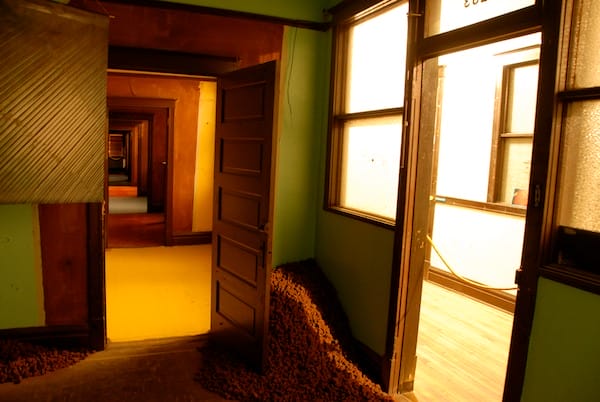
A view of the Flag Room.
The scouring winds after the Certification Riots
After the smoke cleared from the Certification Riots and life returned to something approaching normal, a great scouring wind made the air clearer than ever before, shaping the woods of the now unmoored Embassy Row with its breeze. Seen here is the Great Map of Aedguerre.
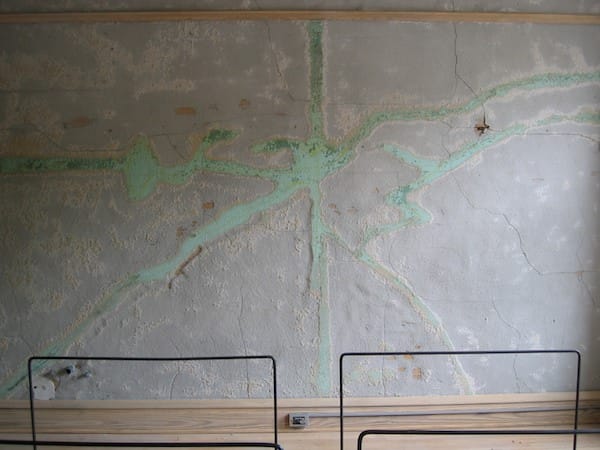
The Great Map of Aedguerre, some say it was exposed by the scouring winds.
In the wake of the Certification Riots
For many generations, this second floor floated above the ground, until finally, a brave builder reconnected it to what we call the Earth.
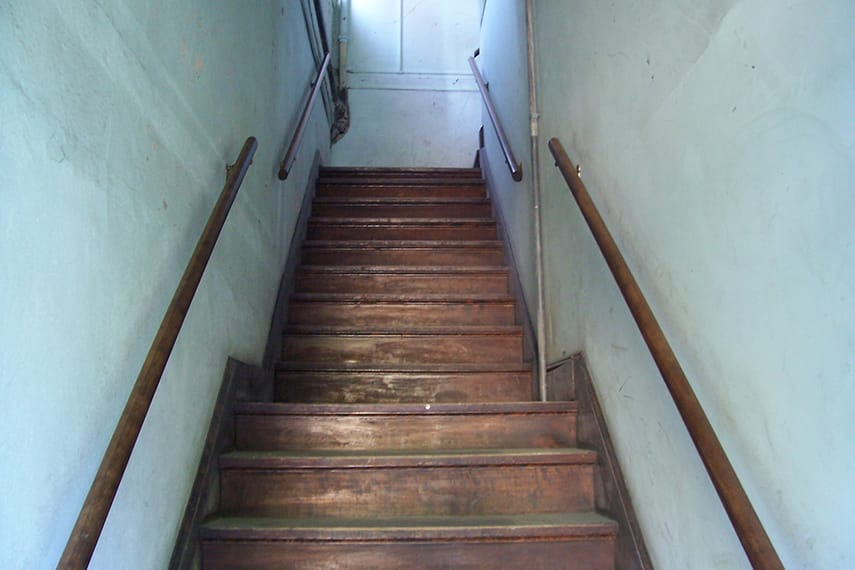
Stairs to the secon floor.

A view of the Flag Room.
What about the Spelling Bees?
The first one took place in 2006. The 9th Annual is set for September 28th, 2014 at 2 PM.
Here is what it is like!
9th Annual Kcymaerxthaere All-Kymaericas Spelling Bee from Green River Films on Vimeo.

Scene from the hard fought 6th Annual Spelling Bee.
The Parisian Diaspora Today
The Parisian Diaspora today bears little resemblance to the role it played throughout Kcymaerxthaereal history. Many blame it on the confluence of the many cultures of the Fraternitée de Touts les Paris. Others just blame it on the Seine.
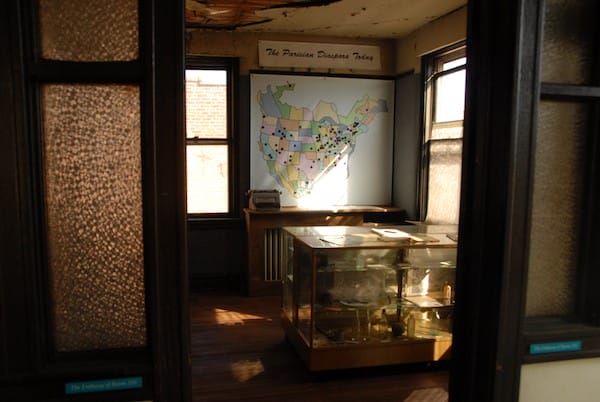
Cabinet has many artifacts from contemporary Parises, potent connections to Frontage’s vision.
The Embassies Themselves
In one of the front rooms, one can see the remains of a floor plan–it shows 16 rooms, which makes sense given that there were 16 gwomes with diplomatic representation here. But a count of the rooms here today offers a surprise. No one is quite sure when that happened.
[PICTURE OF MAP]
Embassies 201 to 204
Embassies 205 to 208
Embassies 209 to 212
Embassies 213 to 216
Gallery
Related Stories
Amory Frontage and his line
- Embassy Row: Heart of the Parisian Diaspora
- Faerie Traces
- Waiting for the Grwost
- Grwostlaven
- Kulver Glade
- Jumomeesta (The Monolith)
- Fort Tayla
- Krblin Jihn Kabin
